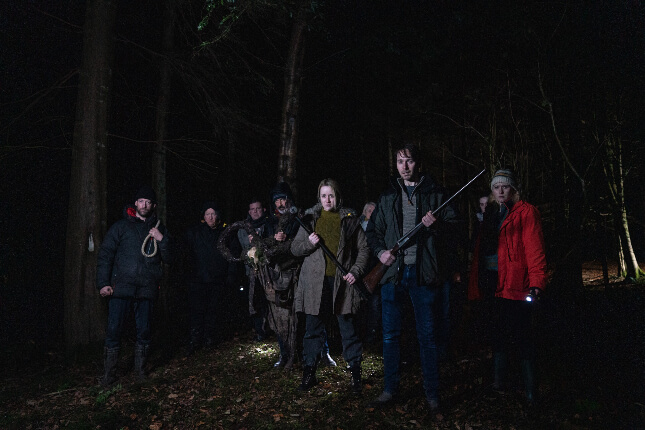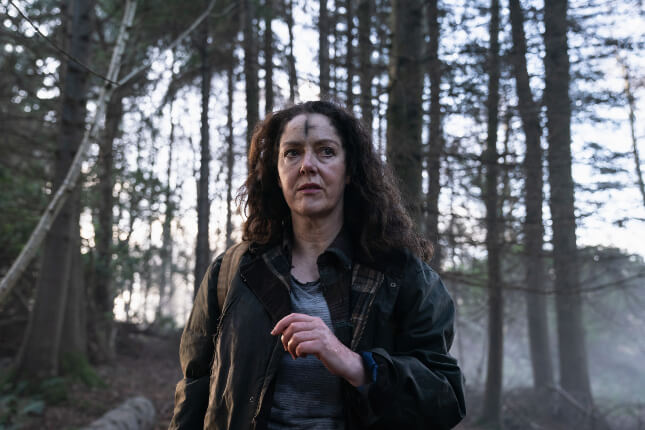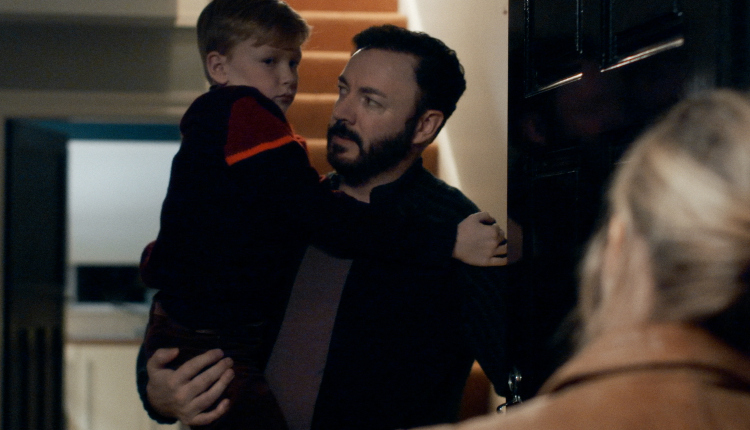Interview | Lynne Davison, Director of Mandrake
Our own Geoff Watkinson sat down with Lynne Davison, director of eerie folk horror Mandrake, which was recently released on Shudder, to talk all things horror. From influential classics and binge-worthy series to handy practical tips, like how much fog is too much fog. Spoiler Alert: You can never have enough!
Regarding art in general—whether it’s films, books, painters, photographers—what have you been checking out the past few months?
I’ve been watching a lot of series, to be honest. I love it when a Mike Flanagan series drops. I really enjoyed Midnight Mass. I didn’t watch it initially when it came out, but I just binged the lot. As soon as I caught hold of the premise of that series, I was in love. Even the soundscape of it was incredible. I mean, I’m not sure whether you’ve seen it, but it harks back to quite a few older things like the original television series of Salem’s Lot.
Then there’s that brilliant one, Cabinet of Curiosities that’s been great fun to watch, even just for the visuals. I have been a sucker for visual effects ever since I was a kid watching The Thing. There’s been quite a lot of stuff that I saw at festivals when I was touring around with the film that were truly remarkable. There’s this film, Speak No Evil—it’s a Dutch-Danish film—and for anyone who hasn’t heard of it or seen it, you need to seek it out. It’s on Shudder as well. It’s about how being polite can get you into trouble.
That gets into my second question—who are your influences?
When I was little, every night was movie night and we watched so much. My mom had such a great taste in cinema. She really loved sci-fi and horror. So, from early age I was watching Alien and Terminator and Terminator 2, and The Thing and Jaws and I would get a little bit scared because it seemed so real. That was my first gateway into filmmaking because mom was like, “Oh, no, this—this is all pretend. And there’s people behind the camera making this.” So that was very exciting and quite formative.

You mentioned Jaws, which is often viewed as one of the instigators for the don’t-show-the-monster technique, even if Spielberg didn’t do it on purpose. How do you think that technique has shaped horror? And how did you approach it for Mandrake?
Well, there are things that you’re taught. You’re taught to show and tell, but you’re also taught that less is more. Jaws is one of the greatest gifts to cinema—that Bruce [the mechanical shark] did not work in the water and they had to create more suspense with it.
Not many things scare me, but I would say darkness scares me and the threat of the unknown. As human beings what scares us is not being able to see a thing. And what the audience can imagine is far worse than what we could put on screen—although I suppose that Cabinet of Curiosities might test that theory!
But for me, we were dealing with a limited budget. One of my producers had to reel me in a bit with some visual effects that I had wanted. We had to keep it subdued and keep it grounded. And I think that lends itself well to keeping your monsters held back for as long as possible. And you want that for your payoff of watching something: you want your audience to be longing for it so much that they get angry if they don’t get to see the monster in the end.
I thought it was interesting that you had said in a prior interview that you wanted the audience to feel like the victims and to feel as disoriented as possible—that this was one of the reasons why the film had to be in the dark. But you also mentioned that there’s a lot of texture to this darkness. I wrote in my review that one of the motifs in Mandrake “is the use of fog, which seems to hang over every frame of the film.” How much discussion went into creating this literal haziness? And did you ever stop and say, “we need more fog?!”
Yes! We absolutely did! The times when we were shooting outside, we wanted that beautiful mist and that depth to the environment because I think, in reality, things aren’t clean. I don’t want to be able to see everything. I want there to be a bit of mystery. And again, that texture to come out from the screen in different ways. I also feel like you can almost smell my film. You can smell the mud. But yes, there certainly were moments when we needed a team in the woods running back and forth with smoke machines and lighting incense and burning things inside just to create an oppressive culture of the film, which serves serves that small community. And when things really kick off, and how trapped Cathy is, I wanted the audience to be able to feel that on so many different levels.

The way that I understand it is that the making of Mandrake was a whirlwind. Was it actually made in 18 days? What was the day-to-day routine like? Did you sleep at all?
Surprisingly, yes, I did sleep! I was doing quite well. I think I was in a better routine then with my sleep than I am now. We did shoot it in 18 days. We did all principal photography in 18 days. We did have an additional week where we did drone work and pickups. And when I say a week, we had a few days of planning. The actual shape was two days when we did all the pickups for inserts and whatnot. That was just in my cinematographer’s living room, which was really fun and kind of a laugh. And I had a little bit of a cameo with my hands on the keyboard when Cathy’s searching the Internet. But we had months of prep. We were set to but then lockdown happened. So, we had months to develop the script a little bit more, but also to prep for the film. I worked so closely with my cinematographer. Many nights we worked on exactly what we were going to shoot because we had such little time on set.
When we were shooting daylight scenes, we were really pressed for that time because, you know, it’s November in Ireland and it gets dark so quickly. And there are procedures in place so that you’re not making people work too much and you have to give an hour when people work late. It was a real balancing act. It’s a wonder that we got through it. I remember driving home in tears because we finally did it and we got through it all and it was in the can.
There was months of editing and my editor, Sean Kelly, he worked remotely in a beautiful little place in Ireland called Dingle, which was fun and a totally new way to do it. I thought we were going to be in Yellow Moon (Irish post-production house) in the editing house the whole time, but because of COVID, we were able to free it up a bit more. Of course, it did impact our lives, but we were still able to live our lives. That was something rare and brilliant and something that probably has eased me in maybe unrealistically to making long form products. But that remains to be seen.
Mandrake is 85 minutes, which is which is relatively short, and yet it’s very much a character driven film. That’s not always the case with horror films. The characters are unique because moral lines aren’t so clear. You’ve said that Mary has her own moral code and that you wanted to hint at her regret. Do you think that the gray area, not just of motherhood, but of morality, is just as important or potentially even more important than the supernatural elements of this film?
Yes, because one of the most frightening things in the world is what people are capable of and what people will do to get what they want. And I’m certainly trying to highlight that in my film. You know, Mary does despicable, horrible things, but to her, it’s completely within her rights to do it. And to incorporate nature, Nature just spirals through. It doesn’t care about our plans. It doesn’t care if you’re good or evil. It simply exists. Life either prevails or fails. And so, I do think that following those gray lines in my characters is very important to me because people are complicated, and there’s something very freeing.
When I was writing and I realized that that whole thing of making your characters likable, of course, is important to a certain degree, but you don’t have to like everybody. And people can be complicated. And the people in my life have been complicated. Especially for Mary. I did a little bit of teaching with an arts foundation here. I was teaching murderers how to make films and write films. And it gives you a great insight into the complexity of human nature, drawing somebody in that Mary exhibits so well.

What other personal experiences have you had that you feel like you brought into Mandrake?
Well, I suppose for me, this was this was a journey I’ve been on since I was a little kid and watching all those amazing films that blew my mind. It’s the culmination of so many things, you know, in those character studies and delving into who people are. Even my personal experience, especially with motherhood. I became the guardian of my niece when I was twenty-five. She was thirteen. She has now graduated university and is doing incredibly well. But my experience of kind of a baptism of fire, of motherhood and dealing with the wants and needs of a teenager constantly, every day, puts you in a really good position to be able to direct an entire crew because you’ve seen the worst and you can get through it.
But even just developing myself as a person: it’s one of the great gifts of life, being a creative. I think you need to live your life and learn and experience things because it informs everything that you do. And I certainly have seen a massive improvement in how I deliver a story now compared to how I delivered the story 15 years ago. If I’m ever talking to students, I always tell them it’s important to make sure you live your life and do other things. We have to have other things in this industry. It makes you more inquisitive and interested in people and what people’s motivations are and who they are. And fundamentally, I’ll never stop being fascinated by that. Every day is a school day, and you have to appreciate that.
What are you working on now? I’ve read that you have a secret nineties horror remake and an apocalyptic Sci-Fi flick in the works.
Well, I have one thing I’m very excited by. It is the post-apocalyptic Sci-Fi. I’ve written it. It came through Northern Ireland Screen Development. It was recently optioned by a production company in London. And I’m going to Los Angeles this Sunday and I’m bringing it alongside of a lot of other things with me to pitch and try to move it into the next stage. I have quite a few things because I’ve been writing for so long and they’re ready to go. They’re ready to be picked up. I just have to find the right people to work with and the right champions who fall in love with my work. So that’s the plan. There are lots of possibilities and I’ve got loads of things in with different people.
Another thing I’m very excited about is I am working on an adaptation of a true haunted house story in Ireland with a production company here in Belfast. And the more and more that I do—the more and more I delve into that subject—the more excited I get. I’ve written a scene, a well-trodden same situation, but I think I’ve done it in a different and exciting way. I can’t wait to put it to screen and see what every
Mandrake is streaming on Shudder now
Featured Image Credit: Shudder via AMC Networks

